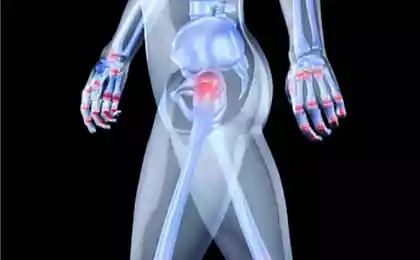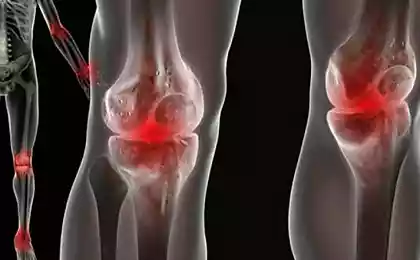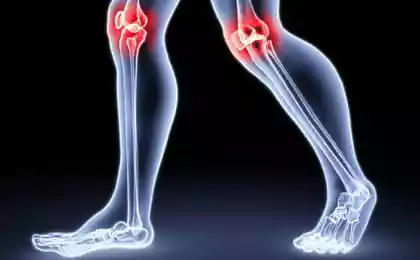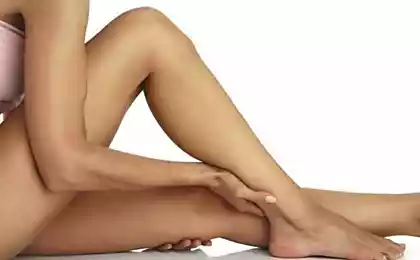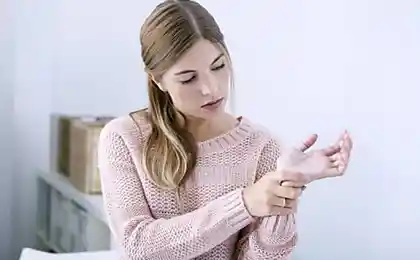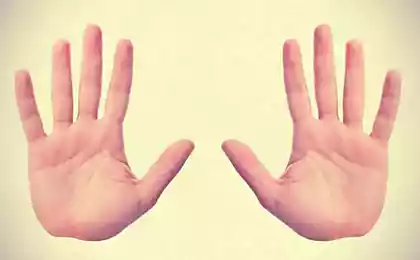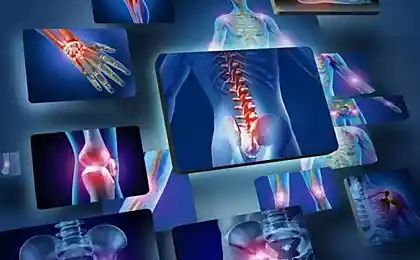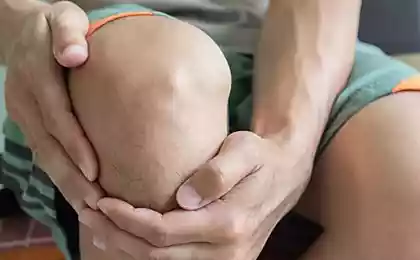506
Crunch in the joints: stop worrying!
Talk about some scientific research that will help us understand that worries of a crunch in joints is not necessary. The crunch in joints is the sound of "cracking" character occurs when passive or active movements. Most often, the crunch is occurring with deliberate flexion (pulling) the fingers into the end position. The crunch may occur in many joints such as the spine, hip, wrist, elbow, shoulder, fingers, knees, jaw, and others. He will also talk about the mechanism that causes this sound. This is cavitation (or ribonuclease) — the formation of small gas chambers in the joint, which are able to dramatically increase the volume of the intra-articular space (happens when we stretch a finger).
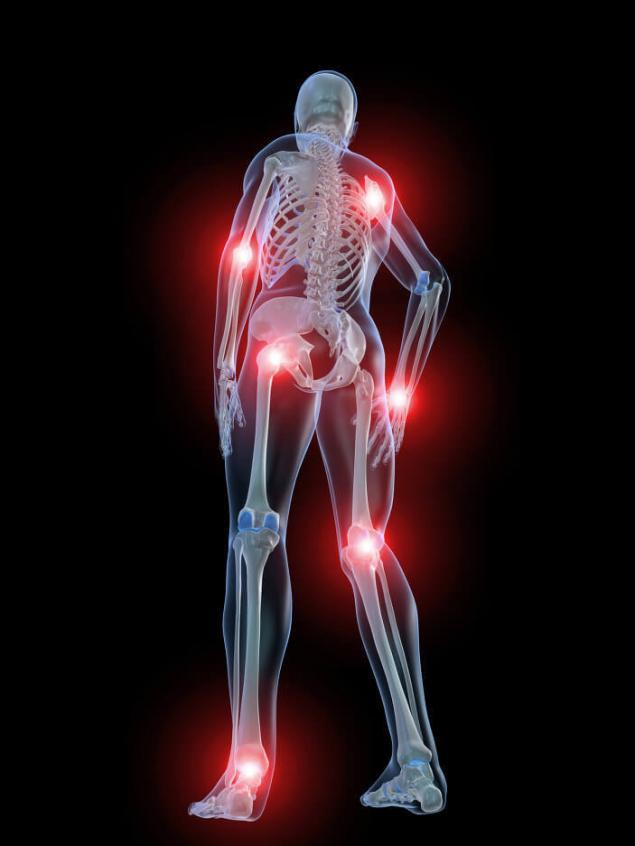
The causes of this crunch was the subject of controversy in the medical literature since at least the 1930-ies, but the consensus among scholars has not been achieved. In 1947, years British researchers first put forward the theory that the cause is the formation in the joints "hollow bubbles". At the moment when contact between the surfaces of the bones in the joint disappears, the pressure of the synovial fluid decreases and dissolved gas is released in bubbles, pop the bubbles as you open the bottle with carbonated water. A hypothesis to explain a snap of the fingers appearance in the joint of the gas bubble put forward 1947, two doctors from the hospital St Thomas ' in London, conducted experiments using a x-ray machine.
Studies have shown that synovial fluid contains a lot of dissolved gas — carbon dioxide (roughly 15% of the total). In 1947, Wheeler Haines suggested (using confirmation obtained by radiographs) that the clicking occurs due to sudden formation of gas cavities, which create the possibility for sudden expansion of the amplitude of motion that produces the sound. However, using high-speed camera, it was shown that the bubbles collapse again in 0.01 second after the occurrence. Later a long time it was believed that the losing of gas bubbles is the cause of the crunching of the joint. Since not all the gas bubbles quanta collapse into the dark it takes some time for its complete dissolution (about 15 minutes) in the synovial fluid, also the time required to articular surface closer (only then can the cavitation effect). For example, when pulling finger, a vacuum is created in the metacarpophalangeal joint, suddenly formed cavity gas, which then instantly collapse, which generates vibration that is transmitted to surrounding tissues. In fact, it turned out that the sound is caused by the formation and not losing bubbles!
Response.
Canadian researchers using magnetic resonance imaging were able to answer the question, why do I hear a crunch, when pulling the finger. This time, scientists led by Professor Gregory Kauchuka (Gregory N. Kawchuk) from the University of Alberta in Edmonton resorted to the technology of the XXI century. They built a device that allowed you to pull a finger at a time, as the hand was in the MRI scanner. The scanner recorded the process at a speed of 3.2 fps.
The result was to establish that the cause of the sound is a phenomenon that physicists call ribonukleaza. When two solid surfaces immersed in a liquid containing dissolved gas, their connection and disconnection can cause the appearance of small gas bubbles. In technology ribonukleazy see, for example, in bearings. In the case of the crunch with your fingers as hard surfaces are bone surrounded by synovial fluid, which fills the joint cavity.

In each case, the crunch and the "divergence" of the joint was associated with the rapid emergence of gas-filled cavity, the bubble in the synovial fluid — only slippery substance that moistens joints. When the surface of the joint is suddenly "different", the liquid becomes insufficient to fill the volume of the joint, therefore creating a cavity, and this leads to the formation of sound.
The behavior of the joint Gregory Kawchuk compares with two attached to each other wet glass plates. They are very difficult to separate, as water film between them creates resistance that must be overcome. That is the sound of the tape if you tear off the ego from the wall, it causes this sound.

And his cause is quickly generated inside the joint cavity. The working title of the study ("Pull my finger") reflects its essence — it so occurred that were recorded by MRI and showed what was happening inside the joints. To find answers a group of issledovatelei needed someone who could crack the knuckles on order, because most people who "crunch" may not always eject the crunch of all fingers and after the break do it again. The fingers of the subject were placed in turn in a tube connected with a cable that is slightly pulled to the crunch in the joint. The crunch was recorded on the MRI in real time and they come every 310 milliseconds.
Conclusion
Crunch in the joints: stop worrying.
1. The crunch is absolutely fine, no harm. But good too.
2. "The ability to crack your knuckles may be related to joint health," says study author Kauchak.
3. Does not cause osteoarthritis. It is popular opinion that crunching deliberately harmful and it can cause a variety of diseases of musculoskeletal apparatus (arthritis, osteoarthritis). Recent x-ray study of 215 people showed that there is no difference in the risk of joint disease in people who crunch with your fingers and not. It also doesn't matter the frequency with which you perform the manipulation.
3. No need to panic. If the crunch in the joints not accompanied by pain, swelling, fever, is cause for panic no, definitely not. If any of these symptoms are present, you should consult a doctor.
4. Shnobel. Dr. Donald Unger conducted its own experiment. He crunched fingers of only one left hand every day for 60 years, after which there were no differences in the brushes. The scientist has received a so-called IG (not Nobel!) the prize for this work in 2009 .
5. The desire to eat. If the crunch is causing discomfort, or desire to crunch joint arises as a way to remove discomfort in the joint, you should find a specialist that can assess the functional status of the joints (usually need to evaluate the biomechanical chain, not just one joint) and muscles involved in the movement (orthopedic surgeon, physiotherapists, physiotherapist, qualified fitness trainer). The constant desire tells about reach many muscular spasms.
6. Neurotic crunch poletsami. In another study found that the habit of cracking knuckles can be correlated with the presence of such habits as Smoking, alcoholism or passion to chew the nails on the hands, i.e. to wear neurotic or stressful nature. It is also worth paying attention to. published
Author: Andrey Blueskin
P. S. And remember, just changing your mind — together we change the world! ©
Join us in Facebook , Vkontakte, Odnoklassniki
Source: www.beloveshkin.com/2015/10/khrust-v-sustvakh-khvatit-perezhivat.html

The causes of this crunch was the subject of controversy in the medical literature since at least the 1930-ies, but the consensus among scholars has not been achieved. In 1947, years British researchers first put forward the theory that the cause is the formation in the joints "hollow bubbles". At the moment when contact between the surfaces of the bones in the joint disappears, the pressure of the synovial fluid decreases and dissolved gas is released in bubbles, pop the bubbles as you open the bottle with carbonated water. A hypothesis to explain a snap of the fingers appearance in the joint of the gas bubble put forward 1947, two doctors from the hospital St Thomas ' in London, conducted experiments using a x-ray machine.
Studies have shown that synovial fluid contains a lot of dissolved gas — carbon dioxide (roughly 15% of the total). In 1947, Wheeler Haines suggested (using confirmation obtained by radiographs) that the clicking occurs due to sudden formation of gas cavities, which create the possibility for sudden expansion of the amplitude of motion that produces the sound. However, using high-speed camera, it was shown that the bubbles collapse again in 0.01 second after the occurrence. Later a long time it was believed that the losing of gas bubbles is the cause of the crunching of the joint. Since not all the gas bubbles quanta collapse into the dark it takes some time for its complete dissolution (about 15 minutes) in the synovial fluid, also the time required to articular surface closer (only then can the cavitation effect). For example, when pulling finger, a vacuum is created in the metacarpophalangeal joint, suddenly formed cavity gas, which then instantly collapse, which generates vibration that is transmitted to surrounding tissues. In fact, it turned out that the sound is caused by the formation and not losing bubbles!
Response.
Canadian researchers using magnetic resonance imaging were able to answer the question, why do I hear a crunch, when pulling the finger. This time, scientists led by Professor Gregory Kauchuka (Gregory N. Kawchuk) from the University of Alberta in Edmonton resorted to the technology of the XXI century. They built a device that allowed you to pull a finger at a time, as the hand was in the MRI scanner. The scanner recorded the process at a speed of 3.2 fps.
The result was to establish that the cause of the sound is a phenomenon that physicists call ribonukleaza. When two solid surfaces immersed in a liquid containing dissolved gas, their connection and disconnection can cause the appearance of small gas bubbles. In technology ribonukleazy see, for example, in bearings. In the case of the crunch with your fingers as hard surfaces are bone surrounded by synovial fluid, which fills the joint cavity.

In each case, the crunch and the "divergence" of the joint was associated with the rapid emergence of gas-filled cavity, the bubble in the synovial fluid — only slippery substance that moistens joints. When the surface of the joint is suddenly "different", the liquid becomes insufficient to fill the volume of the joint, therefore creating a cavity, and this leads to the formation of sound.
The behavior of the joint Gregory Kawchuk compares with two attached to each other wet glass plates. They are very difficult to separate, as water film between them creates resistance that must be overcome. That is the sound of the tape if you tear off the ego from the wall, it causes this sound.

And his cause is quickly generated inside the joint cavity. The working title of the study ("Pull my finger") reflects its essence — it so occurred that were recorded by MRI and showed what was happening inside the joints. To find answers a group of issledovatelei needed someone who could crack the knuckles on order, because most people who "crunch" may not always eject the crunch of all fingers and after the break do it again. The fingers of the subject were placed in turn in a tube connected with a cable that is slightly pulled to the crunch in the joint. The crunch was recorded on the MRI in real time and they come every 310 milliseconds.
Conclusion
Crunch in the joints: stop worrying.
1. The crunch is absolutely fine, no harm. But good too.
2. "The ability to crack your knuckles may be related to joint health," says study author Kauchak.
3. Does not cause osteoarthritis. It is popular opinion that crunching deliberately harmful and it can cause a variety of diseases of musculoskeletal apparatus (arthritis, osteoarthritis). Recent x-ray study of 215 people showed that there is no difference in the risk of joint disease in people who crunch with your fingers and not. It also doesn't matter the frequency with which you perform the manipulation.
3. No need to panic. If the crunch in the joints not accompanied by pain, swelling, fever, is cause for panic no, definitely not. If any of these symptoms are present, you should consult a doctor.
4. Shnobel. Dr. Donald Unger conducted its own experiment. He crunched fingers of only one left hand every day for 60 years, after which there were no differences in the brushes. The scientist has received a so-called IG (not Nobel!) the prize for this work in 2009 .
5. The desire to eat. If the crunch is causing discomfort, or desire to crunch joint arises as a way to remove discomfort in the joint, you should find a specialist that can assess the functional status of the joints (usually need to evaluate the biomechanical chain, not just one joint) and muscles involved in the movement (orthopedic surgeon, physiotherapists, physiotherapist, qualified fitness trainer). The constant desire tells about reach many muscular spasms.
6. Neurotic crunch poletsami. In another study found that the habit of cracking knuckles can be correlated with the presence of such habits as Smoking, alcoholism or passion to chew the nails on the hands, i.e. to wear neurotic or stressful nature. It is also worth paying attention to. published
Author: Andrey Blueskin
P. S. And remember, just changing your mind — together we change the world! ©
Join us in Facebook , Vkontakte, Odnoklassniki
Source: www.beloveshkin.com/2015/10/khrust-v-sustvakh-khvatit-perezhivat.html




